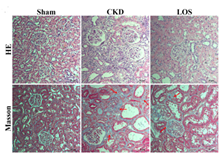Linking renal hypoxia and oxidative stress in chronic kidney disease: Based on clinical subjects and animal models
DOI:
https://doi.org/10.17305/bb.2024.10257Keywords:
Renal hypoxia, oxidative stress, chronic kidney disease (CKD), blood oxygenation level-dependent magnetic resonance imaging (BOLD-MRI)Abstract
The prevalence of chronic hypoxia and oxidative stress plays a key role in the progression of chronic kidney disease (CKD), but the underlying correlations between them need further elucidation. This study aims to explore the relationships between renal function, hypoxia, and oxidative stress in CKD. Seventy-six non-dialysis patients with CKD stages 1-5 and eight healthy subjects were included in the clinical research. They were divided into three groups: healthy subjects, CKD stages 1-3, and CKD stages 4-5. In the animal study, 16 rat models of CKD were established through 5/6 renal ablation/infarction (A/I) surgery, and 8 normal rats were split into 3 groups: Sham, CKD, and losartan groups. Blood oxygenation level-dependent magnetic resonance imaging (BOLD-MRI) was used to measure cortical and medullary T2* values (COT2* and MET2*) in all subjects and rats to evaluate renal oxygenation. Biochemical indicators were used to assess renal function and antioxidant capacity. Furthermore, the effects of losartan on renal fibrosis, hypoxia, and oxidative stress were examined using immunoblotting, colorimetric, and fluorometric assays. The results demonstrated significant positive associations between COT2* and MET2* with estimated glomerular filtration rate (eGFR). Patients with CKD stages 4-5 showed significantly lower serum superoxide dismutase (SOD) levels, which also had positive correlations with eGFR, COT2*, and MET2*. Furthermore, losartan treatment resulted in improved renal function and fibrosis, leading to increased levels of COT2*, MET2*, and SOD levels in 5/6 A/I rats. This was accompanied by reduced levels of hypoxia-inducible factor-1 alpha (HIF-1α) and malondialdehyde. Furthermore, losartan restored the expression of nuclear factor erythroid 2-related factor 2 (Nrf2) and heme oxygenase-1 (HO-1), and suppressed the expression of Kelch-like ECH-associated protein 1 (Keap1) in 5/6 A/I kidneys. The study indicates that decline in renal oxygenation and antioxidant capacity is associated with the severity of renal failure in CKD. Losartan can potentially alleviate renal hypoxia and oxidative stress in the treatment of CKD via Keap1-Nrf2/HO-1 pathway.
Citations
Downloads

Downloads
Published
Issue
Section
Categories
License
Copyright (c) 2024 Yizeng Xu, Fang Lu, Meng Wang, Lingchen Wang, Chaoyang Ye, Shuohui Yang, Chen Wang

This work is licensed under a Creative Commons Attribution 4.0 International License.









